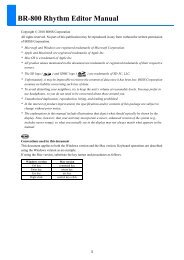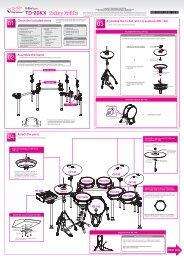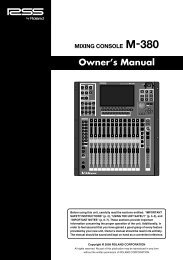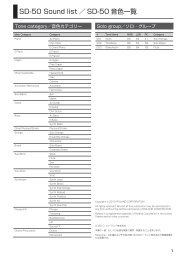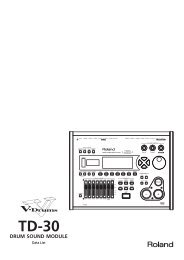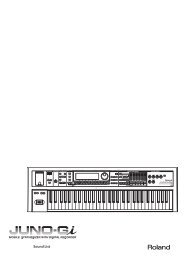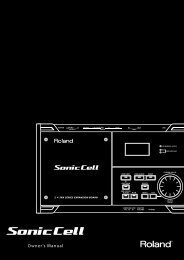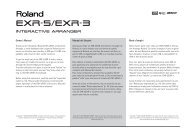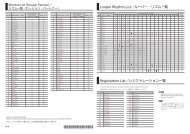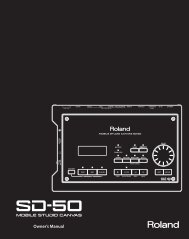- Page 1 and 2:
Exploring Sound WITH THE ROLAND GAI
- Page 3 and 4:
Welcome to the exciting world of so
- Page 5 and 6:
Section 1 Terminology Before we beg
- Page 7 and 8:
TONE versus Tone Throughout this bo
- Page 9 and 10:
Section 3 The Basic Building Blocks
- Page 11 and 12:
Or more correctly as shown in Figur
- Page 13 and 14:
Now let’s experiment with the sof
- Page 15 and 16:
Lesson 2 Signal Sources - Waveforms
- Page 17 and 18:
would oscillate. It created an elec
- Page 19 and 20:
Now play an octave higher. How many
- Page 21 and 22:
Section 2 The Pitch Controls Once a
- Page 23 and 24:
Low Frequency and Audibility Now we
- Page 25 and 26:
OK, now look at the button marked
- Page 27 and 28:
Exercise Try selecting the Pulse wa
- Page 29 and 30:
Lesson 3 Signal Sources - Harmonics
- Page 31 and 32:
Sine Waves Let’s move forward, pl
- Page 33 and 34:
Now try switching on the second TON
- Page 35 and 36:
What are we subtracting? Well, we c
- Page 37 and 38:
You have just been able to prove th
- Page 39 and 40:
Harmonic Series Let’s look again
- Page 41 and 42:
Harmonics Charts Let’s review the
- Page 43 and 44:
Lesson 4 Filters This Lesson will d
- Page 45 and 46:
If we were to lower the bass contro
- Page 47 and 48:
Another very important difference b
- Page 49 and 50:
Please experiment with all three co
- Page 51 and 52:
What you are hearing, and seeing, i
- Page 53 and 54:
Lesson 5 Envelopes So far we have b
- Page 55 and 56:
Envelopes One type of modulator is
- Page 57 and 58:
Section 2 The Trumpet Back in Lesso
- Page 59 and 60:
If you have followed these instruct
- Page 61 and 62:
ut that doesn’t mean you have hot
- Page 63 and 64:
Section 5 Dynamics The Shift Key Ju
- Page 65 and 66:
Section 6 Lesson Five Assignment 1.
- Page 67 and 68:
Lesson 6 Controllers In this lesson
- Page 69 and 70:
Initialize the Patch, and set the L
- Page 71 and 72:
Section 2 It is worthwhile experime
- Page 73 and 74:
What’s Wrong With the Trumpet Sou
- Page 75 and 76:
Key Trigger You now know that by pr
- Page 77 and 78:
Section 5 More Controllers Mono/Pol
- Page 79 and 80:
Experiment with the three methods o
- Page 81 and 82:
Section 7 Pulse Width Modulation Th
- Page 83 and 84:
Lesson 7 The Action List In Lesson
- Page 85 and 86:
Press the one that looks like a Rew
- Page 87 and 88:
Section 2 Editing the Action List T
- Page 89 and 90:
Section 3 File Controls At the top
- Page 91 and 92:
Section 4 Bass Guitar Analysis Now
- Page 93 and 94:
Lesson 8 Combining TONES - Part One
- Page 95 and 96:
It’s that easy! So if you then wa
- Page 97 and 98:
Add Some Detune For the moment swit
- Page 99 and 100:
Section 3 Traditional Synth Patch -
- Page 101 and 102:
Section 4 Oscillator Sync You will
- Page 103 and 104:
Let’s try another version of this
- Page 105 and 106:
Try playing the sound with and with
- Page 107 and 108:
Section 1 Synthesizer Strings One o
- Page 109 and 110:
Step Two Now copy TONE 1 to both TO
- Page 111 and 112:
So now we have quite a convincing
- Page 113 and 114:
Section 2 Real Strings In this sect
- Page 115 and 116: Now follow this Action List: Figure
- Page 117 and 118: Section 3 Real Brass From the previ
- Page 119 and 120: So now we can complete our brass se
- Page 121 and 122: Section 4 Lesson Nine Assignment As
- Page 123 and 124: Lesson 10 Effects We will approach
- Page 125 and 126: So now you can choose which method
- Page 127 and 128: Delay Experiment One Before we expl
- Page 129 and 130: High Damp High Damp stands for High
- Page 131 and 132: Before we leave the delay section l
- Page 133 and 134: All this theory explains why the to
- Page 135 and 136: The Flanger Having explored the tec
- Page 137 and 138: Section 3 Distortion Effects Distor
- Page 139 and 140: Bit Crash Although the Bit Crash ef
- Page 141 and 142: Section 4 Reverb and Boost Reverb I
- Page 143 and 144: Section 5 First Effects Here is a P
- Page 145 and 146: Lesson 11 Combining TONES - Part Th
- Page 147 and 148: From the description of the Electri
- Page 149 and 150: Now for the body of the Electric Pi
- Page 151 and 152: Pad TONE 2 Now that we have our sol
- Page 153 and 154: Final Touches There are just two mo
- Page 155 and 156: Now let’s look at the Spectrum of
- Page 157 and 158: Section 4 Using Noise waveforms In
- Page 159 and 160: Lesson 12 Global Review In this fin
- Page 161 and 162: Section 2 Global Questions Just bef
- Page 163 and 164: Section 3 TONE 1 Oscillator Let’s
- Page 165: Section 5 TONE 1 Amplifier Figure 1
- Page 169 and 170: Section 9 Final Assignment Now it
- Page 171: The Future However, this is not the




